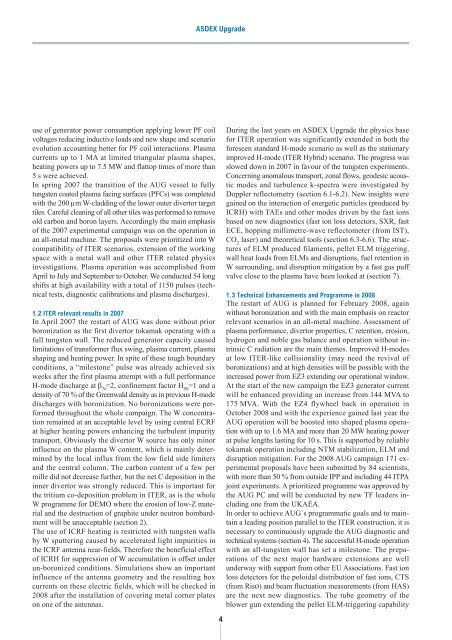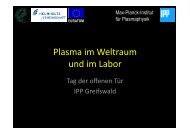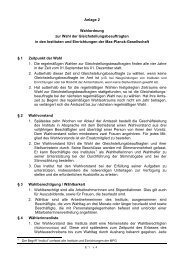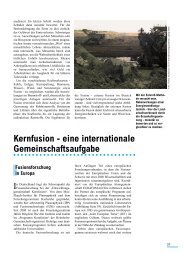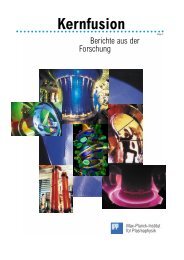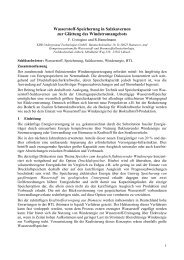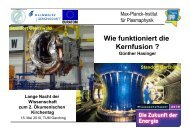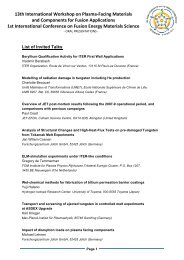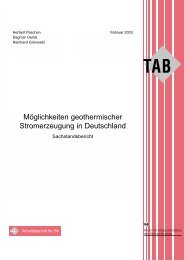IPP Annual Report 2007 - Max-Planck-Institut für Plasmaphysik ...
IPP Annual Report 2007 - Max-Planck-Institut für Plasmaphysik ...
IPP Annual Report 2007 - Max-Planck-Institut für Plasmaphysik ...
Create successful ePaper yourself
Turn your PDF publications into a flip-book with our unique Google optimized e-Paper software.
use of generator power consumption applying lower PF coil<br />
voltages reducing inductive loads and new shape and scenario<br />
evolution accounting better for PF coil interactions. Plasma<br />
currents up to 1 MA at limited triangular plasma shapes,<br />
heating powers up to 7.5 MW and flattop times of more than<br />
5 s were achieved.<br />
In spring <strong>2007</strong> the transition of the AUG vessel to fully<br />
tungsten coated plasma facing surfaces (PFCs) was completed<br />
with the 200 μm W-cladding of the lower outer divertor target<br />
tiles. Careful cleaning of all other tiles was performed to remove<br />
old carbon and boron layers. Accordingly the main emphasis<br />
of the <strong>2007</strong> experimental campaign was on the operation in<br />
an all-metal machine. The proposals were prioritized into W<br />
compatibility of ITER scenarios, extension of the working<br />
space with a metal wall and other ITER related physics<br />
investigations. Plasma operation was accomplished from<br />
April to July and September to October. We conducted 54 long<br />
shifts at high availability with a total of 1150 pulses (technical<br />
tests, diagnostic calibrations and plasma discharges).<br />
1.2 ITER relevant results in <strong>2007</strong><br />
In April <strong>2007</strong> the restart of AUG was done without prior<br />
boronization as the first divertor tokamak operating with a<br />
full tungsten wall. The reduced generator capacity caused<br />
limitations of transformer flux swing, plasma current, plasma<br />
shaping and heating power. In spite of these tough boundary<br />
conditions, a “milestone” pulse was already achieved six<br />
weeks after the first plasma attempt with a full performance<br />
H-mode discharge at β N =2, confinement factor H 98 =1 and a<br />
density of 70 % of the Greenwald density as in previous H-mode<br />
discharges with boronization. No boronizations were performed<br />
throughout the whole campaign. The W concentration<br />
remained at an acceptable level by using central ECRF<br />
at higher heating powers enhancing the turbulent impurity<br />
transport. Obviously the divertor W source has only minor<br />
influence on the plasma W content, which is mainly determined<br />
by the local influx from the low field side limiters<br />
and the central column. The carbon content of a few per<br />
mille did not decrease further, but the net C deposition in the<br />
inner divertor was strongly reduced. This is important for<br />
the tritium co-deposition problem in ITER, as is the whole<br />
W programme for DEMO where the erosion of low-Z material<br />
and the destruction of graphite under neutron bombardment<br />
will be unacceptable (section 2).<br />
The use of ICRF heating is restricted with tungsten walls<br />
by W sputtering caused by accelerated light impurities in<br />
the ICRF antenna near-fields. Therefore the beneficial effect<br />
of ICRH for suppression of W accumulation is offset under<br />
un-boronized conditions. Simulations show an important<br />
influence of the antenna geometry and the resulting box<br />
currents on these electric fields, which will be checked in<br />
2008 after the installation of covering metal corner plates<br />
on one of the antennas.<br />
ASDEX Upgrade<br />
4<br />
During the last years on ASDEX Upgrade the physics base<br />
for ITER operation was significantly extended in both the<br />
foreseen standard H-mode scenario as well as the stationary<br />
improved H-mode (ITER Hybrid) scenario. The progress was<br />
slowed down in <strong>2007</strong> in favour of the tungsten experiments.<br />
Concerning anomalous transport, zonal flows, geodesic acoustic<br />
modes and turbulence k-spectra were investigated by<br />
Doppler reflectometry (section 6.1-6.2). New insights were<br />
gained on the interaction of energetic particles (produced by<br />
ICRH) with TAEs and other modes driven by the fast ions<br />
based on new diagnostics (fast ion loss detectors, SXR, fast<br />
ECE, hopping millimetre-wave reflectometer (from IST),<br />
CO 2 laser) and theoretical tools (section 6.3-6.6). The structures<br />
of ELM produced filaments, pellet ELM triggering,<br />
wall heat loads from ELMs and disruptions, fuel retention in<br />
W surrounding, and disruption mitigation by a fast gas puff<br />
valve close to the plasma have been looked at (section 7).<br />
1.3 Technical Enhancements and Programme in 2008<br />
The restart of AUG is planned for February 2008, again<br />
without boronization and with the main emphasis on reactor<br />
relevant scenarios in an all-metal machine. Assessment of<br />
plasma performance, divertor properties, C retention, erosion,<br />
hydrogen and noble gas balance and operation without intrinsic<br />
C radiation are the main themes. Improved H-modes<br />
at low ITER-like collisionality (may need the revival of<br />
boronizations) and at high densities will be possible with the<br />
increased power from EZ3 extending our operational window.<br />
At the start of the new campaign the EZ3 generator current<br />
will be enhanced providing an increase from 144 MVA to<br />
175 MVA. With the EZ4 flywheel back in operation in<br />
October 2008 and with the experience gained last year the<br />
AUG operation will be boosted into shaped plasma operation<br />
with up to 1.6 MA and more than 20 MW heating power<br />
at pulse lengths lasting for 10 s. This is supported by reliable<br />
tokamak operation including NTM stabilization, ELM and<br />
disruption mitigation. For the 2008 AUG campaign 171 experimental<br />
proposals have been submitted by 84 scientists,<br />
with more than 50 % from outside <strong>IPP</strong> and including 44 ITPA<br />
joint experiments. A prioritized programme was approved by<br />
the AUG PC and will be conducted by new TF leaders including<br />
one from the UKAEA.<br />
In order to achieve AUG´s programmatic goals and to maintain<br />
a leading position parallel to the ITER construction, it is<br />
necessary to continuously upgrade the AUG diagnostic and<br />
technical systems (section 4). The successful H-mode operation<br />
with an all-tungsten wall has set a milestone. The preparations<br />
of the next major hardware extensions are well<br />
underway with support from other EU Associations. Fast ion<br />
loss detectors for the poloidal distribution of fast ions, CTS<br />
(from RisØ) and beam fluctuation measurements (from HAS)<br />
are the next new diagnostics. The tube geometry of the<br />
blower gun extending the pellet ELM-triggering capability


